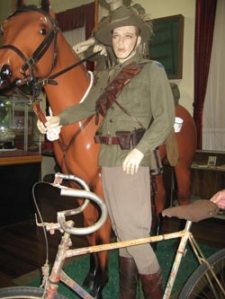Met a local war historian also riding who has an interest in Bendigo Military Museum and in particular locals who fought and served in the armed forces who inspired the following research.
The AIF Cyclists constituted one of the smallest and at the same time least known sections of the AIF. Approximately 1,600 officers and men served with the cyclist units between March 1916 and April 1919. Eleven cyclists were killed in action, or died of wounds as a result of an accident whilst on war service. A further 17 men died of disease.
From the research undertaken so far 2 locals were posted as being attached to Cycling Battalion’s in 1916 who later died in service: George Hamilton Alexander, of Llaney. (KIA 11 APR 1917) and George Henry Clark, also of Llaney. (KIA 18 MAY 1918) and their names are recorded on the Tarnagulla War memorial.
The British system seemed to dictate the use of cyclists and the Australians made limited use of the ranks of cyclist. The choosing of cycles was also a British decision of using the Birmingham Small Arms (BSA) Bicycle and it seems at the time the Australians received a limited amount of what was called MkII Mk III and MkIV and some obsolete cycles being MkI models (which had been in service supposedly since 1901).
The first model were a very rugged single gear steel frame cycle that was fitted out to carry a .303 Magazine Lee Enfield rifle as well as carrying frames with straps (Front and Rear) for carrying of personal affects.
The MkII was introduced in 1902 and were apparently a shorter wheel base (25 1/2 inches as opposed to 27 1/2 inches) free wheel hub with a rear hand brake with inter changeable parts with the MkI.
Further developments were made with the MkIII in 1908 with a new rear Coaster Hub “Military Pattern” in place of the freewheel back hub of the Mk. II. While there were many other developments in the cycle many parts were reputed to be interchangeable.
War time made many developments in bicycles with folding bikes being used by WW2 paratroopers for all nations.
Found this interesting account of a demonstration ride in 1909 which was 1839 kilometre ride by 68 two-man relay teams. At the start point in Adelaide, a military despatch was handed to the first rider by the Adelaide District Commandant. Just under 70 hours later the despatch was handed over to Captain Brand at Sydney’s Victoria Barracks. The relay was repeated in 1912, this time, however, the cyclists competed against teams of motorists and motorcyclists. This time, the cyclists bettered their 1909 time by three minutes and despite taking almost 24 hours longer than the motor car and 18 hours more than the motorcyclists, easily won the event on handicap
